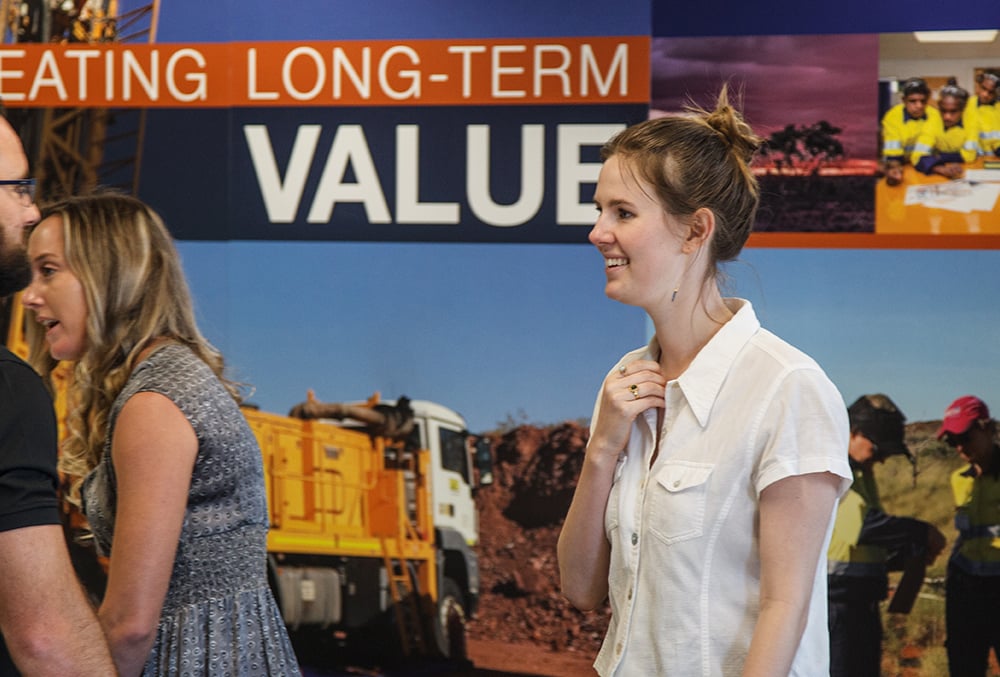Newmont Australia
Hannah
5.00 AM
Staying in a mining camp takes away a lot of the usual morning stresses such as breakfast and public transport. So I roll out of bed, throw on the high-vis, head to the dry mess for an omelette before hopping on the bus to work.
6.00 AM
When I arrive at the office, I grab the crusher and milling grades from the previous shift and walk down to the core shed to meet with the pit technicians for the daily pre-start meeting. We always start with stretches at the pre-start to prepare our bodies for the coming day. We then discuss the safety and production performance of the previous day as well as a plan for the coming shift.
6.30 AM
First things first, we hit up the coffee machine, then settle down to create the daily reports from the previous shifts. This included the crusher feed to mill head grade report, the daily polygon compliance report and the daily trucking data edits.
7.30 AM
Time to prepare for the mark-up this morning. This requires the geologists to create block models of the ore material, which blasted in the previous shift. We work with the survey team, who go out to the heave material and collect the movement of the blast movement monitoring (BMM) devices, which we use to translate the movement of the ore material to minimise dilution. Modelling the blocks requires using the assay information collected from the blast hole sampling and run scripts which calculate the revenue of the material. We use this revenue to create ore blocks.
8.30 AM
While the scripts are running, I squeeze in some other jobs. As the RC rig is currently drilling in the pit, I enter in the drilling PLODS from the previous drilling days drilling. Then I crack open a tray of rock chips from the previously drilled hole and log the rock type, mineralogy and structures of the material. Sometimes we are drilling with an RC rig and sometimes we are drilling with a diamond drill hole (DDH) rig. When the DDH rig is operating, logging of chips is swapped for logging of the core.
11.00 AM
With the ore blocks modelled and translated, it is time to mark-up the ore. With flags, tape, pegs, radios and gas monitoring devices packed into the utes, the pit tech team and I head out to the blasted material to mark it up. We begin with a safety check to identify the hazards and controls associated with the job. We then select a job for the mark-up (today I will be flagging) and head up onto the heave material via the safest route. The boundaries of the blocks are marked with tape and pegs and the interior of the block is demarcated with flags of the block material colour.
1.00 PM
Following the mark-up, I head over to the mine west offices for the daily planning meeting. Here, we discuss the plan for the following 24 hours. With the new information in hand, I head back to the office for lunch.
2.00 PM
At the 1 PM meeting, it was announced that there will be another blast tomorrow, which means that we need to install the BMM’s into the blast pattern. I print off the pattern design and gather the BMM detector and activator and head to the pit tech shed to seek assistance from one or two of the pit techs.
2.30 PM
At the blast pattern, we locate the BMM’s holes using the pattern design map created by the engineers. Then we measure the depth of the hole, record this depth, active a BMM and drop it down the hole. We then shovel stemming/gravel into the hole onto of the BMM until it is full and hold the detector over the hole to store the BMM location data. These balls will be activated when the material is blasted and the movement of the balls will be recorded by survey following the blast to create the material translation used for block modelling. There is a large dolerite dyke crossing the drill pattern, which needs to be mapped by the geologist to update the dolerite model strings in the database. The dolerites meander from bench to bench, so it is important we capture this information to ensure our resource models are accurate. To model dolerites, we examine the blast hole material at the collar of the hole and determine if it is dolerite or not, then we follow the contacts on either side through the blast holes.
3.20 PM
On the way back from BMM’s, I stop by the RC dig to check on how the drillers are going. After a chinwag, I complete a safety inspection of the dig. This addresses the condition of the dig, the housekeeping of the pad and drilling area and the use of correct PPE for the drillers and offsiders.
3.45 PM
Back at the office now and it is time to tie up all the loose ends from the day. This includes washing down the ute, sending any necessary emails and giving the BMM design sheet to the surveyors.

4.00 PM
That’s it! Time to go back to camp and rest up for the coming shift.